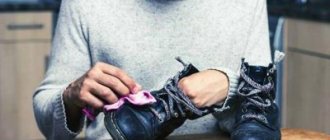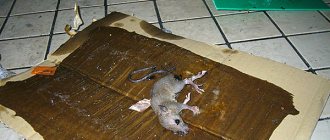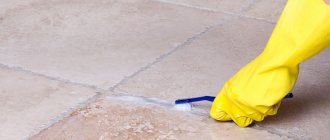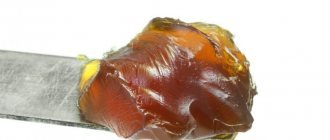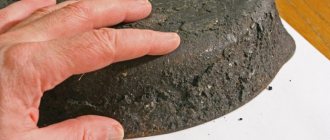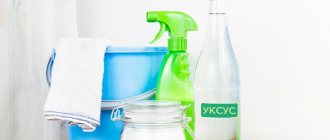Many people choose homemade or purchased glue traps to control rodents. Unfortunately, even the most careful approach to using these products can lead to sticky mass getting on furniture, on the floor, on clothes, on your hands.
The glue that is used to catch mice and rats is particularly viscous, so it will not be so easy to clean it off. Still, there are several tools that can help, the main thing is to know how to use them correctly.
- 3.1 Household chemicals
Types of glue for catching rodents
To catch mice and rats, use either ready-made traps or hand-made traps using special glue. Traps can be in the form of plates or containers, and the glue is available in hermetically sealed tubes with a volume of 130 - 150 ml. The composition of glue from different manufacturers may differ slightly, but the main components are most often the same - these are:
- polybutylene - a plastic polymer is used as a binding element;
- cycloisan - a polymer that promotes long-term preservation of adhesive properties;
- polyisobutylene (analogue of polybutylene).
Natural or synthetic rubber, vegetable and mineral oils are used as additives.
Rules for caring for glass ceramic hobs. How to use…,
How to prolong the shine and preserve the beauty of glass ceramics in the kitchen
Discussion
Good rules. I can say from myself that it has never been a big problem for me to take care of my hotpoint; it’s nice to take care of beautiful equipment so that it continues to look like new. And so with everything in the house,)
Thank you for your practical advice, although I have a glass-ceramic stove, I didn’t know much, especially about its care. Well, the cookware must be appropriate for such a stove; I use cast aluminum cookware called Litta from the VARI brand. It’s a pleasure to cook on such a stove with such utensils. Nothing burns, it’s easy to prepare without any hassle, and it’s easy to care for.
Handy tools for removing glue
To wash off glue, you can use products that can be found in any home. Good results show:
- vegetable oil;
- dishwashing detergents;
- lemon juice;
- laundry soap;
- kerosene.
Before you begin processing, you need to make sure that the selected product can be used on the specific material that has been stained. Otherwise, you can clean off the glue, but ultimately ruin the item.
Vegetable oil
Vegetable oil has proven itself as a means for washing various sticky substances. In addition, this product is absolutely harmless and can even be used to clean hands or animal fur.
To properly clean rat glue, you need to generously moisten the stained area with oil and leave for 7 to 10 minutes. During this time, the oil will dissolve most of the adhesive mass. After this, the remaining glue is wiped off with a sponge. Then the oil is washed off with warm soapy water.
Dish detergent
Available in a large assortment of dishwashing products from the store, this is another way that many housewives quite successfully wash off glue intended to get rid of mice.
The product gives the best results when treating fresh stains or when carrying out repeated cleaning after the bulk of the glue has already been cleaned off by other methods.
Attention! The effectiveness of this method largely depends on the specific product chosen, since the compositions of dishwashing detergents differ from different manufacturers.
Kerosene
When choosing how to remove old glue stains, many people decide to use kerosene. Indeed, this product combats various adhesive stains quite effectively. To avoid inhaling toxic fumes, treatment should be carried out only in a mask or respirator.
Also, do not forget that kerosene leaves a sharp, unpleasant and, most importantly, very persistent odor. Kerosene also dries out the skin very much. So, when washing your hands or cleaning pet hair, it is still better to choose another product that removes glue.
Lemon juice
Many people reasonably believe that the more natural the product, the safer it is, so they remove the glue with lemon juice. To be honest, this option is far from the most effective. It only helps to remove the remaining sticky substance after more powerful products have dealt with the main contamination.
Lemon juice
Laundry soap
Many housewives consider laundry soap to be a magical remedy that helps in a wide variety of situations. It is also used to wash off mouse glue as best as possible.
Soap can be used to remove glue from children and pets, and to clean clothes made from delicate fabrics. It also helps remove stains left by other cleansers, such as oil.
What danger do they pose?
The composition itself is a very sticky mass in which all living things get stuck tightly.
It is this property that gives us the answer to the question of why it can be so difficult to wipe it off clothes and the body. Rat glue
If you are already familiar with this method of control first-hand, then you probably know that there are both special adhesive compositions that you need to apply yourself, and ready-made adhesive traps, where the sticky layer is already on the substrate. From this it is clear that most often you can get dirty using products packaged in metal tubes, since contact with the material cannot be avoided.
When using glue, you must adhere to safety precautions
Here are some rules for safe handling:
- first of all, when working with glue, you need to wear rubber gloves to protect your hands;
- It’s better to also change clothes to ones that you don’t mind getting dirty;
- It is better to apply the composition to the substrate with a brush or sponge, since it stretches in thin threads that settle on everything around;
- Traps should be placed in places inaccessible to children and pets.
A stained wooden floor is quite susceptible to chemical solvents, but paint or varnish may come off along with the glue.
Use these substances with great caution. The same applies to linoleum - you can wash off the glue from a floor with such a coating using the same compounds as from the skin, and also try to carefully scrape off the mouse repellent with a knife. The floor is washed with chemical compounds
The floor is washed with chemical compounds
A mouse infestation in itself is a nuisance. These are small, dirty, unpleasant creatures that brazenly invade pantries and nightstands for food. Rodents cause harm not only to food, furniture and the integrity of walls, they pose a danger to human health:
- In some people, products used by mice cause an allergic reaction.
- Close proximity to pests carries the risk of infection with infectious diseases. Mice are carriers of bacteria and germs.
- Gray rodents damage wiring and cable communications, resulting in a short circuit in the network.
- Causative agents of dangerous infections live in the saliva and droppings of pests. With the appearance of mice, fleas enter the room, living in the short fur of basement rodents.
- Mice spoil food products: they “drill” holes in bags of flour and cereals, eat through packages of pasta, grind seeds, crackers, and bread. Rodents do not disdain vegetables, leaving teeth marks on potatoes, carrots, and cabbage.
After death, the corpses of mice must be removed as quickly as possible, since the cadaverous smell of rodents is toxic to people and can cause severe headaches or poisoning.
When uninvited guests enter residential premises, they damage furniture, books and other products. They make nests in the far corners of pantries, dragging small wardrobe items. Rodents damage shoes, clothes, wallpaper and, among other things, spread a disgusting smell.
Means to wash off glue
If you find glue that has dried on the carpet, upholstered furniture or clothing, it is best to contact a dry cleaner. Our specialists have at their disposal the most powerful modern tools, equipment and, of course, experience that will help get rid of the most difficult contaminants. But you can try to wash the glue yourself, for example, using household chemicals.
Household chemicals
Products designed for washing glass, cleaning stoves and ovens, washing sinks and toilets help remove mouse glue. They contain chemicals that break down limescale, rust, grease, and other contaminants, so to a greater or lesser extent they will also cope with the sticky suspension from rodents.
You can use stain removers to remove glue from fabrics and carpets.
However, one cannot vouch for the effectiveness of a particular drug. If the glue does not come off after several attempts, then the selected product is not suitable either for this type of glue or for the material being cleaned.
Fat
In addition to vegetable oil, you can try to remove mouse glue by using:
- cosmetic oils (the glue is unlikely to dissolve, but may peel off from the surface);
- petrolatum;
- fatty cosmetic cream.
It is difficult to say how effective these remedies will be, but in such a situation it is worth trying all available options, especially if they are absolutely safe.
Description of the problem
The composition that traps small rodents is specially developed from viscous polymers that have a melting point below room temperature, so it does not harden or dry out like solutions.
In most cases, the base (up to 80%) is polybutylene with the addition of cycloisane and polyisobutylene.
The suspension can be applied to old cardboard
Polymers are not toxic, but do not interact well with weak solvents.
These glue traps are available in 2 types:
- ready-to-use traps in the form of a strip with an adhesive layer covered with a protective film for transportation,
- suspension in tubes (jar), which is applied independently to the selected base in accordance with the manufacturer’s recommendations.
Most often it is necessary to clean the contaminants obtained when applying or accidentally touching exactly 2 types of traps.
Hard case
The performance characteristics of mouse glue are specifically designed to instantly adhere to organic surfaces.
The manufacturer warns about the need to wear rubber gloves and recommends using the following solvents:
- kerosene,
- acetone,
- alcohol.
For the skin of the hands, exposure to these liquids in small quantities is usually acceptable, but removing the sticky mass from hair, pet fur, or fabric upholstery in this way will be not only difficult, but also practically impossible.
Safe ways to remove sticky glue from hair are:
- A haircut. If only the ends of long hair (wool, lint) are dirty, then it is better to trim them carefully, since treatment with synthetic or organic liquids will cause more damage to the undamaged part. It is recommended to choose this method for pets as well, otherwise it will take a lot of patience for both the pet and the owner while washing off the glue.
- The use of natural solvents (sunflower oil) and/or household chemicals. This is a more labor-intensive process, since it is necessary not only to remove dirt, but also to remove oil and synthetic detergents that are absorbed into the skin and hair. Grease removers (for example, dishwashing liquid) are used from household chemicals.
Oil will remove glue residue well, but not always the first time
Oil not only dissolves polymers, but also activates the process of self-cleaning of living tissues (the work of the sebaceous glands) and then mechanical removal of the adhered mass occurs along this film, so it is not always possible to remove the stain the first time.
In such cases, use an oil compress - generously lubricate your hand and wrap it in a thick cloth for 15-20 minutes, then rinse it off with a degreaser.
Glue that has been absorbed from fabric threads is unlikely to be washed off without damaging the appearance of the fabric base. In this case, it is better to seek help from a dry cleaner.
Removing glue from the floor
Most often, mouse glue ends up on the floor. This can happen when traps are laid out, or if a rodent trying to escape is able to overturn the trap. You must first try to scrape off the glue from the hard surface of the floor. You can use a construction spatula, a plank, or sandpaper.
Removal from the floor
You must select a device and act carefully so as not to damage the floor covering. This especially applies to wooden, painted or varnished floors, and laminate floors. It is also important not to smear the glue further on the floor.
When choosing how to remove mouse glue from the floor, you should pay attention to the following products:
- vegetable oil;
- alcohol;
- acetone;
- laundry soap.
If there is linoleum on the floor, you can use stronger products, such as solvent.
Glue-based traps
These devices come in the form of:
- finished board on which glue is spread. The components of the substance attract rodents;
- mouse glue in tubes - the difficulty is the uniform application of the substance. It is not able to dry completely.
It is worth noting that when applying liquid glue to a cardboard surface, it is thrown away after catching one mouse. Otherwise, the decomposition process will begin. The advantage of the adhesive is the absence of toxins.
How to remove mouse glue from clothes and fabric?
Removing mouse glue stains from clothes is quite difficult. Many products that can cope with a sticky suspension negatively affect the condition of the fabric or discolor it. Therefore, removing glue from clothes using aggressive products (toilet bowl cleaner or solvent) is most often a bad idea.
It may be possible to clean clothes with vegetable oil, but whether it will be possible to remove the greasy stain later is a big question. So this method remains questionable. You can try to wash the glue by hand with laundry soap. If the stain is small and the wash is repeated several times, then it is quite possible to achieve a good result.
Attention! The surest way to clean glue without ruining the item is to use dry cleaning services.
Instructions for use
Even though the glue does not contain toxic substances, it can cause harm. Therefore, you should not ignore safety precautions. Don't forget that you are working with a very sticky product that can instantly stick to any surface, including your hands. Follow the four rules.
- Latex gloves. To protect your hands from the adhesive, be sure to wear rubber gloves. After work, wrap them up and throw them away.
- Workwear. While working with glue, a few drops may fall onto your clothing. It is best that these are unnecessary old things that you can throw away with a light heart.
- Safety precautions. Even when wearing gloves, do not apply glue with your fingers. Use a large brush or waste sponge. Rubber gloves can tear easily, especially when the glue begins to set. After work, be sure to wash your hands with hot water and soap.
- Keep your household safe. While catching rodents, it is advisable to resettle those household members with whom it is extremely difficult to come to an agreement (small children and pets). Explain to adults where the traps are set. At the same time, try to choose places that are difficult for humans to reach. If this is not possible, then close the door to the room completely until the rodents are caught.
Application technology
The usage algorithm includes four steps.
- Preparation. Take any dense material: cardboard, plywood, a piece of plastic, wood. Cut a piece measuring 10x10 cm if you plan to fight mice, and 20x25 cm if war is declared on rats.
- Installation. Choose a place for the future trap along the walls, near holes, in corners, behind furniture. Carefully secure the substrate with tape (cardboard) or self-tapping screws (wood, plywood), otherwise the rat will easily drag your trap along with it.
- Luring. Apply glue to the attached base. To enhance the effectiveness of the trap, place bait (smoked lard, sausage, a piece of bread with vegetable oil, sunflower seeds) in the center.
- Examination. Place the next trap at a distance of 2-15 m. Inspect your traps periodically. Replace clogged traps with new ones immediately.
Apply glue to the base in strips of 1-2 cm, maintaining a distance of 5 cm between them. If you are fighting rats, then make the stripes wider, approximately 3-5 cm, and increase the distance to 7-10 cm.
Destruction of caught rodents
It is an extremely unpleasant sight to see a half-dead animal trying to escape from a trap. But it’s even worse to hear his squeak and be subjected to a long, painful death. To kill a rodent, use two methods.
- Suffocation. Transfer the trap and rodent to a plastic container. Combine baking soda and vinegar in a separate container and place it inside. Close the container tightly with a lid to prevent air from entering. When baking soda reacts with vinegar, it will begin to release carbon dioxide. Lack of oxygen will lead to loss of consciousness, and the rodent will die painlessly.
- Poisoning. Take a rag and soak it in acetone or gasoline. Cover the rodent with it. The animal will quickly lose consciousness. Just as in the first case, he will die painlessly.
Carbon dioxide asphyxiation is the only method of exterminating rodents that has been approved by the Veterinary Medical Association of America as the most humane method.
From a pet
If a pet accidentally gets stained with mouse glue, measures must be taken immediately, otherwise the animal will begin to wash itself off and end up with a sticky substance, which is very dangerous.
A haircut
Before you try to wash mouse glue off your cat or dog, you should try cutting it off. If it is not possible to completely cut off the matted fur, you need to use vegetable oil. It is applied to the sticky spot and left for 10 - 15 minutes, carefully watching so that the pet does not begin to lick itself. After this, the glue is carefully combed out or washed off from the fur of the cat or dog. Then the animal needs to be bathed with shampoo or laundry soap.
